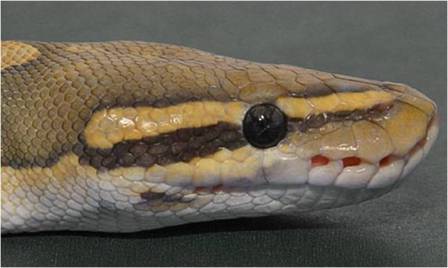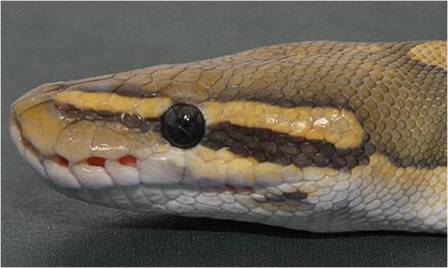|
|
||||||||||||||||||||||||||||||||||||||||||||||||||||||||||||||||
CHARACTERISTICS: Ball pythons are robust serpents with a distinctive head & slender neck. Normal body coloration is black with yellow, gold, or brown markings. Pattern may be "broken," banded or reduced in some specimens, and many exhibit varying degrees of broken dorsal striping. Generally docile and good natured. When threatened it may roll into a ball and hide its head. REQUIREMENTS: Tropical temperatures of 80-92F. Enclosure at least as long as the animal's body and width at least a third of the animal's length. Buy captive-born whenever possible. Ensure the animal is feeding. DIET: Mice, rats, gerbils, and in the wild, jerboas. SIZE: Hatchlings approximately 10"+/-. Adults average 3'-5', this is a species in which mature females are typically distinctly larger than the males. A 5' animal is considered large, although lengths of 6+ feet have been reported. Comparison with other python species. LIFE SPAN: Ball pythons may live 35+ years or more in captivity. BREEDING: Sexual maturity reached in the first 2-4 years. Breeding season in captivity: November-April. Animals should have excellent weight and be established before any breeding is attempted. Breeding induced by night time temperature drops into the low 70's. Misting the animals with water may be beneficial. Animals breed during the rainy season in the wild. Lay 4-8 eggs, maternally incubates. Incubation temperature 88-90F(optimal), 70-85 days to hatch. Infrequently bred in captivity. COLOR MUTATIONS (MORPHS): Normal, T- Albino, T+ Albino, Lavender Albino, Albino Spider, Arctic, Axanthic, Burgundy Hypo, Bumble Bee Spider, Caramel Glow, Cinnamon Pastel, Coffee, Classic Jungle, Clown, Coral Glow, Desert Ghost, Ghost Hypos, Hypermelanistic, Killer Bee Spider, Lemon Pastel, Leucistic, Mojave, Melanistic, Patternless, Pearl, Piebald, Platinum, Snow, Spider, Striped (genetic), Super Pastel, Woma Ball & many more exist but are rare in the market and command high prices. STATUS IN THE WILD: Large populations exist but are being reduced due to excessive habitat destruction, skin trade and the pet trade. In some collected areas the populations remain stable due to agricultural activities and the created artificial rat populations. In Ghana, Africa the ball python trade is regulated by the government and attention is put into keeping a viable population of adults in the wild to create the next generations for future collection. Gravid females are collected and then returned to the wild by government officials; a percentage of the babies hatched are also being released back into the wild. Treating these animals as a sustainable resource has possibly increased the local population range, and may help to secure the future of these animals in the wild. In other countries, however, ball pythons are collected with absolute disregard for the "overall picture" and impact on wild populations, and are sold as meat or living animals. Adults are now being exported in huge numbers to the Asian markets where they are being used for their meat and blood, Recently there has been interest in butchering & canning the ball pythons in Africa for export as a meat product for the Asian markets. This single activity could bring the demise of large populations, as they can not sustain such losses without wiping out entire areas. Until the government takes notice Benin and Togo are draining themselves dry of their ball python populations. DISTRIBUTION: Central and Western Africa. ADDITIONAL COMMENTS: Ball pythons are often regarded as the most popular pet python in herpetoculture, and with their docile nature & low maintenance requirements it is easy to see why. Acquiring captive bred specimens will help ensure a successful snakekeeping experience. The myriad color morphs that are now available, combined with the fact that normal ball pythons are quite attractive in their own right, truly make this species a snake for both novice and advanced herpetoculturist alike. CAPTIVE MAINTENANCE GUIDELINES:
HOUSING SETUP Enclosure: Cages must be escape proof, easy to disinfect,
free of sharp edges, ventilated, and hold heat to ensure proper
temperatures. A 36" x 18" x 12" enclosure will more than comfortably house an adult ball python. Avoid unfinished wood and porous surfaces when designing
custom cages; these surfaces are difficult to clean and disinfect. Heating: Variable under cage heating pads, thermostatically controlled light and /or under cage heat strips, and hot rocks. Don't use a small hot rock for an animal that is proportionately larger; burns often result if the animal is forced to rest on this type of heat source. A heat source should warm 1/3 to 1 /2 of the cage with a basking floor temperature of 88-92F. Use a thermometer! The unheated area should never drop below 75F. It may be necessary when using aquariums to cover part of the lid with plastic to maintain ideal temperatures. It is essential to allow the animal an area that provides an optimal basking temperature and a cooler area so that the snake can thermoregulate. Caution should be used when using lamps. If the heat is extreme it may dry out the animal, create health problems, kill or burn the animal. It is better to heat with an under cage heater and a lamp. Red lights may be used for heating during the night since this type of light does not disrupt the animals photo period. Avoid large wattage bulbs(100watt+) when possible. The heat provided is often too focused and may burn! Lighting: 12 hours on, 12 hours off, incandescent or fluorescent. Never leave visible lights on continuous, this causes stress. Furnishings: A water dish large enough to allow the animal to soak located near the heat source. Always provide clean water, disinfect bowl weekly. A hide box or shelter in the heated end of the cage provides security. A hide box may also be provided in the cooler area; always locate at least one in the heated end so the animal does not have to choose between security(from a hide box) and a warm area. A climbing limb that has been disinfected, avoid untreated branches and rocks since they may harbor ecto parasites. Substrates: Newspaper, paper towels, paper bags, or artificial grass are safe and inexpensive. Aspen bedding also may be used but it is advisable to feed on a different surface, since it could lodge in the snake's mouth. Gravel, sand, mulch and shaving may cause health problems such as intestinal blockage, skin lesions and "mouth rot." Cedar is deadly to reptiles! Cleaning: A solution of water, detergent and 5% household bleach is safe and disinfects, rinse surfaces thoroughly with clean water after cleaning.
FEEDING Small, frequent meals are recommended until an animal is established and no longer a hatchling /juvenile. A baby ball should begin feeding on small jumper mice(15-21 days old) or rat crawlers. A snake may be induced to feed by placing it in a locking plastic shoe box style container(with air holes) with crumpled newspaper and leaving it for an hour, then introduce a food item. At 1.5' the snake is large enough for adult mice or small rats. At 2' it is capable of consuming weaned rats. Frequent feedings of 1-2 times weekly will result in quick growth and a healthy animal. Adults often take meals as large as 2/3 grown rats. Offer food items at least once every 10-21 days. Ball pythons may refuse to feed during the winter months and resume feeding months later. Many animals may be conditioned to accept pre-killed or thawed rodents(warmed) at feed time. This technique is safer, than feeding live rodents since this prevents the snake from being bitten by the rodent. Shedding is dependent on the animals growth rate and condition and may occur every month or several times a year. Ball pythons often refuse feeding attempts while shedding. Avoid handling after a sizable meal; this is stressful and may cause regurgitation. Never leave a rodent in the snake's cage for lengthy periods; a rodent can cause serious damage to your pet! Provide food & water for any rodent left in the snake's cage longer than 30 minutes. Never handle rodents and then handle a snake; you may be mistaken as food. Develop proper feeding habits. Maintain accurate feeding and health records. Reluctant Feeders: May be more apt to eat at night or with lights off, and may prefer to ambush prey from a hide box. Try a variety of rodents and sizes. Is the animal sick? Reduce handling to a minimum. If an animal refuses all feeding attempts, consult a veterinarian or an experienced keeper to force feed the animal(may require 3-6 feedings).This often stimulates an animals metabolism and a feeding response.
HANDLING Always support the snake's body; avoid fast movements. Do not treat the snake as a toy. Avoid techniques which restricts a snake's movement. Avoid public situations which draw attention to the animal since this is stressful to the animal and possibly your audience. A nervous snake may occasionally bite; if biting occurs and is a problem, wear gloves. The handler must convince the snake that it is safe, trust must be learned. Snakes bite for two reasons: they have mistaken you as food or they are in fear of their safety. Snakes do not bite because they are mean.
|
|
||||||||||||||||||||||||||||||||||||||||||||||||||||||||||||||||


